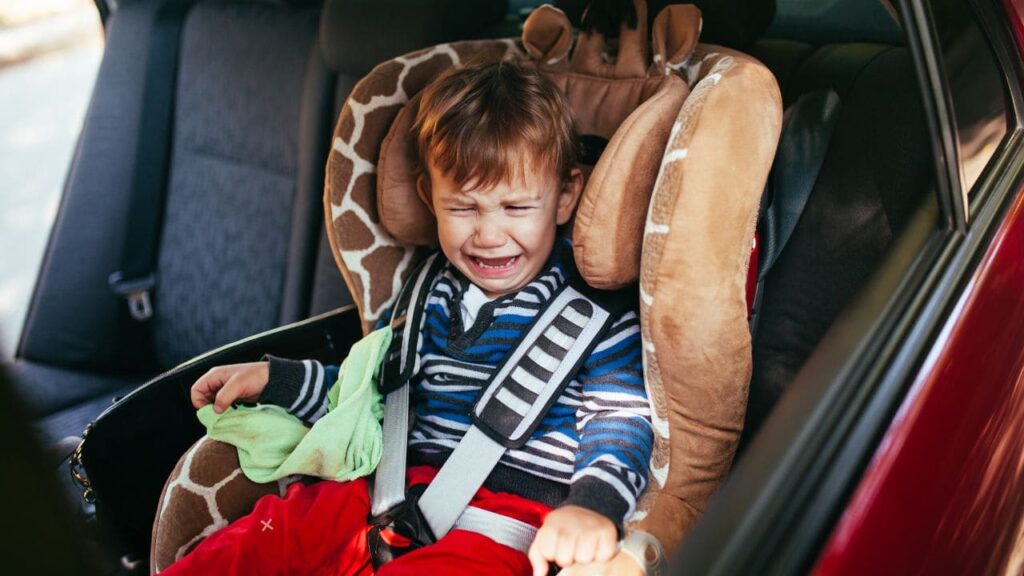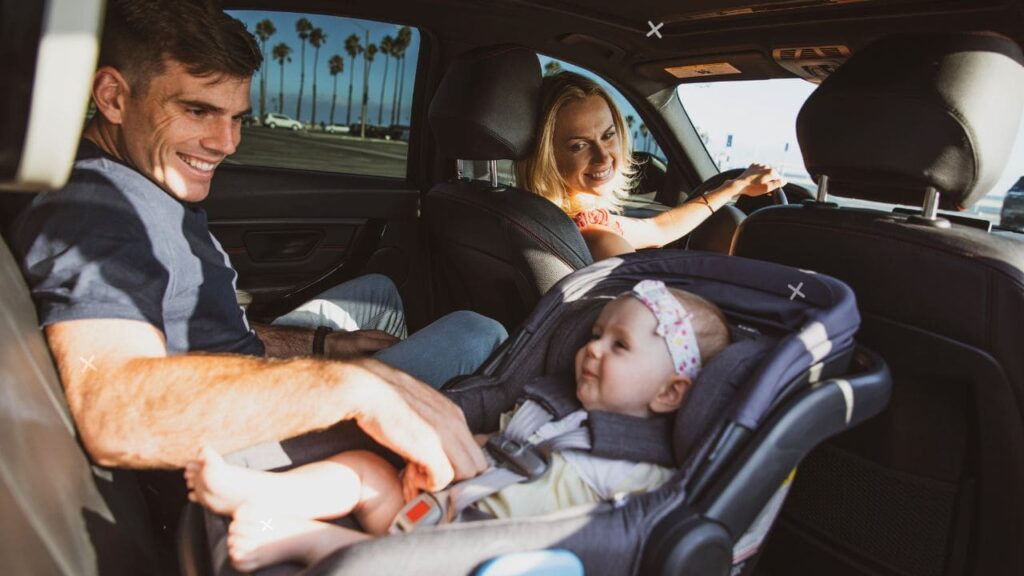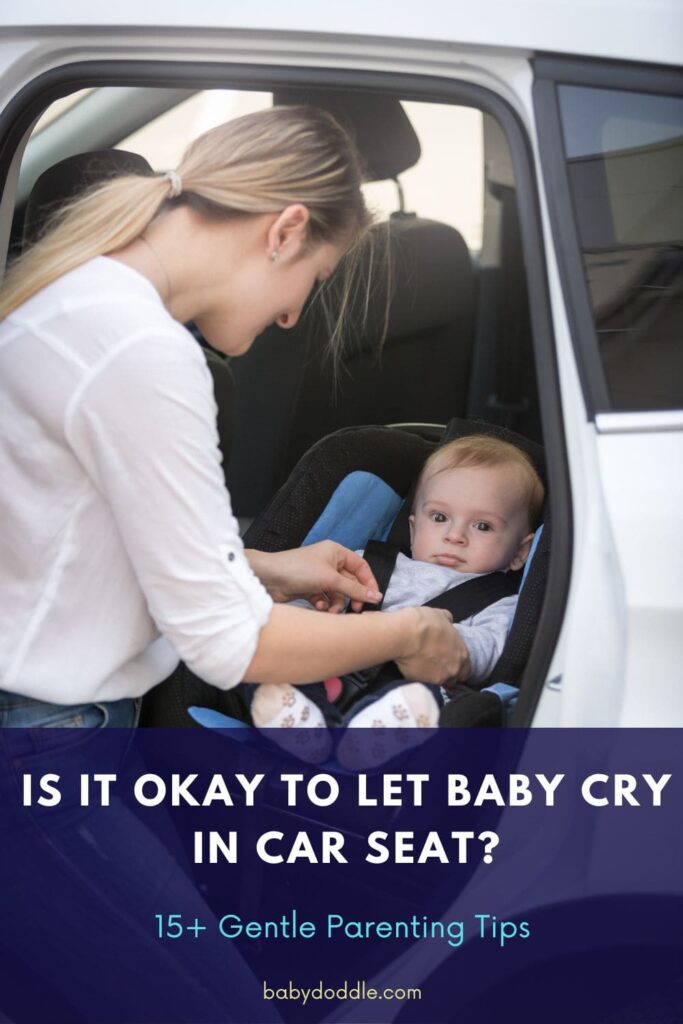As a parent, hearing your little one cry can be heartbreaking. But when you’re driving and your baby is wailing from the car seat behind you, it presents a difficult situation. Your instinct may be to immediately pull over and comfort them. However, that could jeopardize safety if done in an unsafe area without proper precautions.
So what’s a gentle parent to do? How do you balance responding to your baby’s needs with keeping everyone safe on the road? I’ll cover some key things to consider.

Preparing Your Baby for a Car Ride
Before you even head out the door and strap your baby into their seat, there are several proactive steps you can take to set them up for car ride success:
Feed baby right before leaving – A full belly prevents hunger-induced cries mid-drive. Time the last feeding so they finish eating about 10-15 minutes before you buckle them in. Offer breast or bottle – solids stay and digest slower.
Change baby’s diaper pre-trip – Sit them down for a fresh, dry diaper change immediately before hitting the road. Eliminate Wetness or mess irritation for better comfort. For longer trips, have extra diapers and travel wipes handy.
Dress baby in breathable comfy clothes – Check the weather and dress them in light, loose layers good for the car temperature. Going too heavy or too cold equally brings misery. Think breathable kinds of cotton.
Spend calming time together before departing – If the baby is prone to over-tired meltdowns, build in some pre-drive chill time doing quiet activities to refresh their mood. Read stories, sing songs, cuddle – avoid overly energetic play.
Briefly put baby in car seat beforehand – Right before you head out, after securing them in the seat, sit with baby buckled in for 2-3 minutes while parked in the driveway or garage. It builds familiarity in a no-pressure setting.
Say cheerful but quick goodbye to home – Whisk them away with upbeat energy – smiles, giggles, a favorite toy or blanket for company. Don’t let them get engrossed in home playthings you’ll soon remove. Exit while things are still positive!
Laying this groundwork before ever backing out of the driveway powerfully sets you both up for lower-stress traveling. An ounce of prevention is worth a pound of cure!
Why Babies Get Fussy in Car Seats
Before diving into what to do when your baby cries in the car, it helps to understand the common reasons behind it. Some main causes include:
Discomfort from poor fit: On average, 73% of car seats are improperly installed. An ill-fitted car seat can dig into their back or pitch them at an odd angle that strains their developing muscles and bones. Ensuring proper installation and routinely checking the fit as the baby grows can help.
Overstimulation from sights and motion: The gentle sway and constant sights and sounds of a moving car can overstimulate a baby’s developing senses and nervous system. Some babies have more sensitive temperaments and get overwhelmed more easily in the car.
Boredom: Being strapped in one place with limited entertainment can simply bore some babies after a while or make them fussy if they’re tired of looking at the same toy.
General fussiness or needing soothing: Babies cry to communicate their needs. Sometimes they just want to be held, rocked, sung to, etc. Getting upset from needing such soothing is common.
Health issues: Ear infections, teething pain, acid reflux, hunger, and other medical problems could also be the culprit behind car seat crying if it seems excessive. Checking with your pediatrician can provide helpful clarity and treatment if that’s the case.
So in summary – physical and emotional discomfort, overstimulation, boredom, general need for nurturing connection, or health issues can all trigger babies to cry in the car. Understanding the “why” provides important context.
Is It Safe to Leave a Crying Baby in the Car Seat?
Now to tackle the main question: when it’s unsafe to stop immediately, is it okay to leave your baby crying in their car seat for a stretch until you reach your destination or a safe pullover spot?
The short answer is yes, if necessary, but longer durations of intense crying should be avoided, especially for very young infants. Here’s a more nuanced look at things to consider:
Signs it may be safe to leave them crying for now:
- Baby is simply fussing or whining intermittently
- It’s stop-and-go traffic so stopping isn’t possible
- You’re on the highway or busy road with no shoulder
- There are no safe nearby exits for 5-10+ minutes
In situations like these, it can be safest for everyone to wait until reaching their destination or a protected pullover area before tending to the baby.
Signs you should pull over ASAP to respond:
- Blood curdling screaming or inconsolable crying
- Baby sounds like they’re in distress or panicking
- High-pitched cry or strange breathing
- Lasted 15+ minutes already
- Safe exit is nearby
If you notice these more concerning signs, gently responding takes precedence over continuing to drive. But again – only pull over where permitted and completely off the road. Don’t veer onto the shoulder or stop short unsafely.
If stopping right away isn’t possible: Narrate to your baby that you hear them but can’t stop this moment. Hearing your soothing voice can help, even if you can’t hold them yet. You can also try dangling toys from their seat handles for distraction. Just don’t take your eyes off the road for more than a split second.

Strategies to Help Babies Become Happy Travelers
While sometimes leaving a crying baby strapped in is unavoidable, there are several things you can try preventatively to help them tolerate car rides:
Proper car seat installation: Get your baby’s seat professionally inspected to ensure proper angle, harness tightness, and security. Review the car seat manual and your car’s manual for specifics on appropriate installation. An improper fit can cause major discomfort leading to crying.
Familiar toys and books within reach: Once parked, let your baby explore toys they enjoy in their seat so the environment gains positive association. Secure engaging toys like crinkle books or soft blocks to the handle where they can reach them while strapped in. Rotate toys between drives to combat boredom.
Soothing music: Play calming songs, lullabies, or white noise from a CD player or screened device to drown out overstimulating car sounds. Alter the playlist over time so variety keeps their interest.
Mirror for eye contact: Mount a baby-safe mirror on the headrest so you can make facial expressions while driving. Seeing your face is comforting and helps them feel less isolated.
Stop if very distressed: If possible, pull over to offer soothing contact if your baby reaches extreme distress – at least for a minute or two to help re-regulate.
Validate feelings verbally: Narrate understanding of their cries so they feel heard. “You’re letting me know this car seat is bugging you. I get it. We’ll be home soon.”
Remain calm: Babies sense stress. Your own tension will stress them more. Focus on steady breaths and peaceful music even if the baby is still upset.
Trying that full toolbox of ideas could help your child stop seeing car rides as the enemy and instead approach them with less dread. Be patient with experimentation.
| Goal | Action |
|---|---|
| Ensure proper fit | Re-check installation every 6 months as baby grows |
| Provide entertainment | Secure engaging toys within reach to combat boredom |
| Play preferred sounds | Tailor music or white noise to baby’s mood |
| Offer connection | Mount a baby-safe mirror for making eye contact |
| Address physical needs | Pull over if possible to feed, change or soothe baby |
More Tips to Reduce Car Seat Crying
A few other ideas that may help minimize restless behavior:
Check fit of car seat: Re-test the installation every so often as the baby grows. Make sure straps are snug enough without compressing their chest. You should only be able to squeeze one finger width between the strap and the clavicle.
Provide entertainment: Secure engaging toys within view and reach. Rotate options to prevent boredom. Sing songs and play music too.
Play entertaining or soothing music: Tailor the audio to the baby’s mood. Upbeat songs can energize while soft instrumentals can soothe.
Adjust vehicle temperature: Babies easily get too hot or cold. Keep climate control at 72-75 degrees and dress them appropriately in breathable layers if needed.
Hang mirror for familiar face: Mount a shatterproof baby mirror on the back seat headrest facing their seat. Making eye contact with your reflection is reassuring.
Let baby get used to car seat: When parked at home for feedings, sometimes place baby in the seat with music on. This builds positive associations before driving anywhere.
Rule out health issues: If crying seems extreme, check for ear infections, reflux, teething pain or other medical problems that could contribute. Treat any found issues.
Be patient: Almost all babies outgrow excessive car seat crying by one-year-old as their development advances and familiarity increases. This too shall pass!
Try not to lose hope or get road rage. Work through that bag of tricks until you find the right formula for your child.

When to Upgrade Your Car Seat
Installing your baby’s car seat properly is extremely important, but it isn’t a one-and-done deal. As your child grows, they will need seat upgrades to keep them protected. Here’s a simple guide:
Rear-facing until age 2 – Current AAP guidelines recommend rear-facing at least until age 2. Many pediatricians and car seat companies now advise rear-facing even longer – some until age 4 – due to the enhanced safety for young spines and necks.
Forward-facing usually between ages 2-4 – Once your convertible seat’s rear-facing height and weight limits are reached, you can flip it forward-facing. This is safe once the baby has good head/neck control and surpasses the manufacturer guidelines, usually by age 2-4.
Booster seats from about age 4 to age 8 – When forward-facing limits are exceeded, baby graduates to a belt-positioning booster seat until at least 4’ 9”. This more mature positioning allows proper seat belt positioning for smaller bodies, usually fitting kids from about age 4 to age 8.
Vehicle seats alone often not until around age 12 – Due to chest and skeletal development, safety groups advise against children using lap and shoulder belts without boosters until they pass 5 feet tall and 110 pounds. This equates to close to age 12 for many kids.
Consult your car seat and vehicle manuals along with pediatrician guidance on the right time to “level up” your child’s model with these developmental milestones in mind. Proper protection remains crucial as they grow!
| Age | Recommended Car Seat Type |
|---|---|
| Newborn to age 2 | Rear-facing only car seat or rear-facing convertible |
| Age 2-4 | Forward-facing convertible if over height/weight limits |
| Age 4-8 | Belt-positioning booster seat |
| Age 8+ | Vehicle seat belts |
Using Pacifiers in the Car
What about popping in a pacifier to soothe a fussy baby? Pacifiers can be miracle workers, but there are pros and cons to consider:
Pros:
- Allows for self-soothing without caregiver intervention
- Distraction from environmental overstimulation
- Satisfies need to suck for comfort
- Avoids escalation to crying
Cons:
- Choking hazard if baby spits it out while unattended
- Can fall and get dirty or lost, requiring replacement
- Overreliance could interfere with language development if overused long-term
- Reduced caregiver interaction since it substitutes actual nurturing
As with most things, moderation is key. When used judiciously under watchful supervision on occasion, pacifiers seem reasonably safe for the car. Just ensure you find one that fits baby’s mouth securely, like those by reputable brands like Philips AVENT. Check pacifier safety guidelines for size and design.
And never substitute actual nurturing and bonding for overuse of any “plug-in” solution. Hardest as it is, sometimes babies just need to cry for healthy processing and communication. Support them through big emotions when you’re able.
When to Seek Help for Excessive Crying
If you work your way through all the tips but your baby still cries nonstop on every trip, to the point of physical illness or panic, it may be worth consulting their pediatrician to explore whether an underlying physical, neurological or mental health issue could be at play. Digestive problems like reflux or sensory processing disorders are examples.
In such cases, medication, therapy modalities, or dietary changes could help dramatically reduce suffering for the child. Seeking professional guidance is wise.
In other instances, it really is just a phase in which further experimentation and age will improve. Some gentle parenting specialists suggest trying a “car seat challenge” where you experiment with slight adjustments over multiple short drives to pinpoint preferences:
- Swap positions (rear/forward-facing)
- Adjust harness tightness
- Angle seat differently
- Play different music genres
- Hang different toys
- Open windows
- Try morning drive versus afternoon
- Turn on the fan or heat
- Go on a straight drive versus winding back backroads
Tracking details during the desensitization process helps determine the right combo of factors to create the happiest car environment for each unique baby. Customization takes work but pays off!
Extra Car Travel Tips for Long Trips
If you have a road trip or long daily work commute with your baby, a little extra planning goes a long way toward a tear-free journey:
Plan stops every 1.5 to 2 hours – Babies have short fuses. Regular breaks let you stretch legs, attend to baby’s needs quickly, and minimize the duration spent potentially crying.
Pack extra everything – Carry surplus changes of clothes, burp rags, diapers and non-perishable snacks in case of messy incidents, hungry tantrums, etc. Preparedness is key!
Invest in vehicle window shades – For overnight travels, quality shades greatly darken interior light allowing baby to sleep in daylight. Some cling directly to windows via static for simple install.
Secure familiar sleep associations items – To help baby relax into slumber, clip or prop their special loveys, traveling sound machine, and pacifiers within reach. Recreating their ideal sleep space comforts them when far from home.
Book overnight stays with kitchenettes – When selecting lodgings, kitchen access allows washing bottles, storing breastmilk, heating purees, etc. Pick suites over single rooms when possible.
Announce “Baby on Board” – Display stickers or hang signage declaring the baby’s presence to prompt extra caution from other drivers. Every little bit of accident avoidance helps protect your precious cargo!
Implementing even just a few of these tips takes preparation to the next level for confidently hitting the open road with your tiny co-pilot!
| Category | Items |
|---|---|
| Transportation | Car seat, car seat toys, window shades, white noise machine, baby on board sign |
| Feeding | Bottles, formula, pumped breast milk, non-perishable snacks/food |
| Diapering | Diapers, travel wipes, diaper disposal bags, changing pad, extra clothes |
| Sleeping | Sound machine, lovey/pacifier, car seat sleeper |
| Medical | Thermometer, gas drops, gripe water, saline spray, medications |
| Activities | Books, soft blocks, rattles, singing toys |
| Lodging | Pack n play, outlet covers, kitchenette, blackout curtains |
Key Takeaway on Car Seat Crying
Hearing our babies cry pulls at the heartstrings for good reason. We’re wired to respond. But when driving, safety must come first. If stopping right away would endanger everyone, sometimes you have to tune out the tears until reaching your destination or a protected breakdown lane.
That said, this dilemma often arises from a lack of planning, patience, and prevention. Proactively working to make the vehicle space more baby-friendly can dramatically reduce upset behavior over time for many children. Check medical issues, proper seat fit, entertainment options, soothing sounds, and other environmental factors. Slowly acclimate them through repetition in safe scenarios.
While we can’t always prevent cries, especially with babies, trying that full toolbox of tips goes a long way. Meeting their needs consistently outside the car also provides an emotional security that carries over.
So next time your little one wails from their seat, know it’s usually not willful manipulation. Implement more ideas from the lists above, pull over the very second it’s legal and safe to provide contact comfort, and just breathe through what you can’t control in the interim. This too shall pass! With preparation and effort, the once anxious baby often morphs into a more resilient, balanced rider – one road trip at a time.
FAQ – Is It Okay to Let Baby Cry in Car Seat?
Is it damaging to let my baby cry it out in their car seat?
Letting your baby cry for an extended time without responding could be damaging according to some research. However, when driving, brief crying periods may be unavoidable for safety reasons before you can pull over. Generally try to respond within 5-10 minutes if possible by finding a protected breakdown area to comfort the baby. If the crying is extremely intense, pull over at the earliest and safest opportunity. Leaving a baby screaming in major distress should be avoided.
What if my baby hates the car seat and cries every single drive?
Some babies suffer from colic or sensory issues that make them prone to cry excessively in the car seat regardless of responsive parenting efforts. In those persistent cases, have your pediatrician evaluate potential solutions like treatment for reflux, different car seat brands, physical therapy, adjusting radio noise and temperature levels in the vehicle, etc. Finding the key triggers takes trial and error but can improve tolerance over time.
Is it unsafe for the driver to glance back frequently to check on baby?
Yes, while the instinct to look back when you hear crying is understandable, it can be dangerous to glance away from the road for more than a split second while operating a moving vehicle. Instead of taking visual check-ins, ask your passenger or older child riding along to observe baby’s needs and relay if stopping seems warranted. Rely more on verbal communication and your auditory sense until you can fully pull over safely.
What’s the shortest amount of time I can leave an infant crying?
Even brief moments of intense emotional distress contrary to an infant’s age and needs can be damaging according to some research. For very young babies under 6 months especially, try to respond as soon as humanly possible by pulling over – even just for one minute of soothing contact before strapping back in. The younger the baby, the shorter the crying duration should trigger action. Extending your drive by a few minutes is worthwhile to nurture a baby’s emotional brain development with connection when big feelings arise.
Do I always need to fully stop the car to comfort my crying baby?
Legally parking off the highway or a protected breakdown area is safest for responding hands-free, especially with a very upset infant where holding them could provide the greatest soothing. However, if you’re caught in bumper-to-bumper rush hour traffic for example with no quick exits available, briefly sticking your arm back to rub baby’s chest or offer a pacifier while still crawling ahead in gridlock could be safe enough while not prolonging crying duration exponentially. Just don’t fully take your eyes off the road ahead or cars around you. Stopping fully is ideal but not always feasible.












